Content

Options can be quite complex, but at a basic level, you are locking in the price of a stock you expect to increase in value. If your crystal ball is right, you benefit by purchasing the stock for less than the going https://business-accounting.net/ rate. If it is wrong, you can forgo the purchase and you’re only out the cost of the contract itself. When you purchase a bond, you’re allowing the bond issuer to borrow your money and pay you back with interest.
What are the 3 major types of investment styles?
Investments fall into three basic groups or asset classes: stocks, bonds and cash or stable value.
With conventional cash flows (-|+|+) no conflict in decision arises; in this case both NPV and IRR lead to the same accept/reject decisions. The NPV method is used for evaluating the desirability of investments or projects. International/Global bond funds use the global bond market as the universe of securities from which to select. Natural resources funds invest primarily in companies engaged in the exploration, distribution, or processing of natural resources. Health funds invest primarily in healthcare companies, including drug manufacturers, hospitals, biotechnology, and other related fields.
Performance and Accountability Report
Initially, investments are recorded for the consideration given to acquire the assets. However, subsequent treatment of the investment varies depending on the nature of the assets. Further, some investments are recorded in the net income, and some are recorded in the other comprehensive income. Further, impairment testing needs to be performed if there is any indication regarding a reduction in the worth of the asset or fair value has declined.
- For example, an investor may purchase GE stock to gain the densification benefits of a company in the industrial sector, without realizing that they may also be getting exposure to the financial sector.
- As an investor, you have a lot of options for where to put your money.
- If your crystal ball is right, you benefit by purchasing the stock for less than the going rate.
- Primary MarketThe primary market is where debt-based, equity-based or any other asset-based securities are created, underwritten and sold off to investors.
- When evaluating offers, please review the financial institution’s Terms and Conditions.
- It is the discount rates for the market rate of interest that are important – ie 8%.
In the FR exam, you will only have to deal with convertible instruments from the perspective of the issuer, being the person who has received the cash on issue of a convertible instrument. They will usually take the form of convertible loan notes or convertible debentures . The issues arise when the balance may be repaid at a premium or initial transaction costs were incurred. For example, the terms of the $10m loan, issued on 1 January 20X1, may be that the holder receives interest of 5% a year, but then receives $11m back at the end of the three-year term, on 31 December 20X3. This means that the holder is now earning finance income in two different ways. Secondly, they are earning another $1m over three years in the form of receiving more money back than they invested.
Related IFRS Standards
These may include investment in stocks, bonds, property, mutual funds, exchange-traded funds, commodities, hedge funds, etc. It’s important to note that investments are made by a business to generate a return. However, some investments can be riskier in nature and generating higher returns and vice versa. All the investments are recorded as an asset of the business irrespective of their nature.
Domestic high-yield funds invest in lower-rated corporate bonds and floating-rate securities. Funds investing in both corporate and government bonds are included in this category. Domestic government funds invest in taxable bonds issued, or backed, by the U.S. government, and include mortgage-backed securities. Emerging market funds invest primarily in companies based in less-developed countries of the world. Small-cap funds invest primarily in companies The Classification of Investments with small market capitalizations of up to $2 to 2.5 billion. Mid-cap funds invest primarily in companies with medium market capitalizations, generally ranging from $1 billion to $7 billion or in companies with both small and medium market capitalizations. Large-cap funds invest primarily in companies with large market capitalizations, which are generally more than $5 billion or in companies with both medium and large market capitalizations.